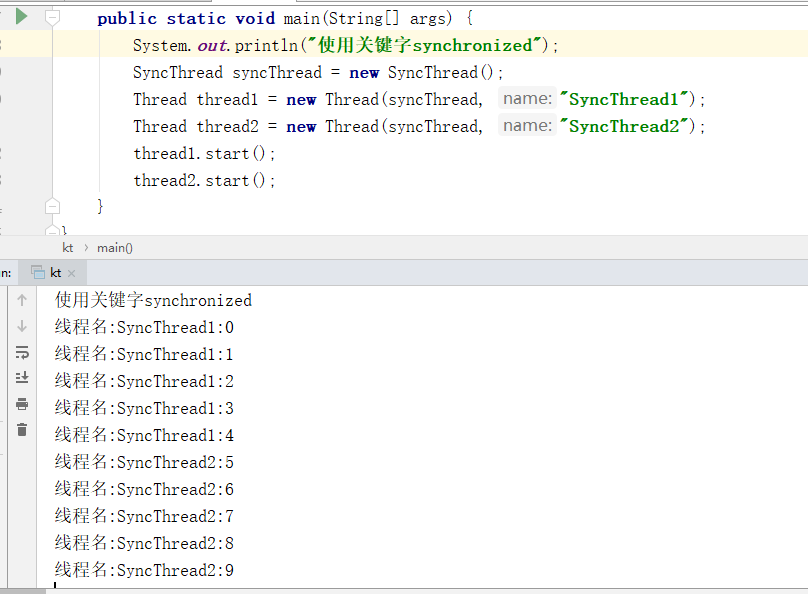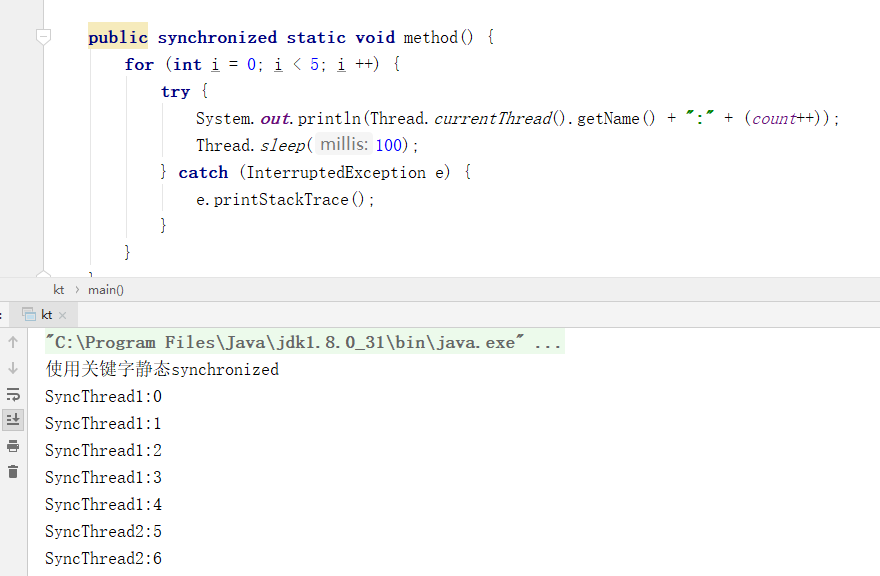# 简单介绍
# synchronized 是 Java 中的关键字,是一种同步锁。它修饰的对象有以下几种:
1. 修饰一个代码块,被修饰的代码块称为同步语句块,其作用的范围是大括号 {} 括起来的代码,作用的对象是调用这个代码块的对象;
2. 修饰一个方法,被修饰的方法称为同步方法,其作用的范围是整个方法,作用的对象是调用这个方法的对象;
3. 修改一个静态的方法,其作用的范围是整个静态方法,作用的对象是这个类的所有对象;
4. 修改一个类,其作用的范围是 synchronized 后面括号括起来的部分,作用主的对象是这个类的所有对象。
# 修饰一个代码块
1、一个线程访问一个对象中的 synchronized(this) 同步代码块时,其他试图访问该对象的线程将被阻塞。
例子:
1
2
3
4
5
6
7
8
9
10
11
12
13
14
15
16
17
18
19
20
21
22
23
24
25
26
27
28
29
30
31
32
33
34
35
36
| package com.wbg;
import java.util.ArrayList;
import java.util.List;
public class kt {
public static void main(String[] args) {
System.out.println("使用关键字synchronized");
SyncThread syncThread = new SyncThread();
Thread thread1 = new Thread(syncThread, "SyncThread1");
Thread thread2 = new Thread(syncThread, "SyncThread2");
thread1.start();
thread2.start();
}
}
class SyncThread implements Runnable {
private static int count;
public SyncThread() {
count = 0;
}
public void run() {
synchronized (this){
for (int i = 0; i < 5; i++) {
try {
System.out.println("线程名:"+Thread.currentThread().getName() + ":" + (count++));
Thread.sleep(100);
} catch (InterruptedException e) {
e.printStackTrace();
}
}
}
}
public int getCount() {
return count;
}
}
|
# 使用关键字 synchronized 运行结果

# 不使用关键字 synchronized 运行结果

当两个并发线程 ( thread1 和 thread2 ) 访问同一个对象 ( syncThread ) 中的 synchronized 代码块时,在同一时刻只能有一个线程得到执行,另一个线程受阻塞,必须等待当前线程执行完这个代码块以后才能执行该代码块。 Thread1 和 thread2 是互斥的,因为在执行 synchronized 代码块时会锁定当前的对象,只有执行完该代码块才能释放该对象锁,下一个线程才能执行并锁定该对象。
我们再把 SyncThread 的调用稍微改一下:
1
2
3
4
5
6
7
| public static void main(String[] args) {
System.out.println("使用关键字synchronized每次调用进行new SyncThread()");
Thread thread1 = new Thread( new SyncThread(), "SyncThread1");
Thread thread2 = new Thread( new SyncThread(), "SyncThread2");
thread1.start();
thread2.start();
}
|
# 运行结果

为什么上面的例子中 thread1 和 thread2 同时在执行。这是因为 synchronized 只锁定对象,每个对象只有一个锁( lock )与之相关联,而上面的代码等同于下面这段代码:
1
2
3
4
5
6
7
8
9
| public static void main(String[] args) {
System.out.println("使用关键字synchronized每次调用进行new SyncThread()");
SyncThread syncThread1 = new SyncThread();
SyncThread syncThread2 = new SyncThread();
Thread thread1 = new Thread(syncThread1, "SyncThread1");
Thread thread2 = new Thread(syncThread2, "SyncThread2");
thread1.start();
thread2.start();
}
|
这时创建了两个 SyncThread 的对象 syncThread1 和 syncThread2 ,线程 thread1 执行的是 syncThread1 对象中的 synchronized 代码 ( run ),而线程 thread2 执行的是 syncThread2 对象中的 synchronized 代码 ( run );我们知道 synchronized 锁定的是对象,这时会有两把锁分别锁定 syncThread1 对象和 syncThread2 对象,而这两把锁是互不干扰的,不形成互斥,所以两个线程可以同时执行。
# 二、当一个线程访问对象的一个 synchronized(this) 同步代码块时,另一个线程仍然可以访问该对象中的非 synchronized(this) 同步代码块。
# 多个线程访问 synchronized 和非 synchronized 代码块
1
2
3
4
5
6
7
8
9
10
11
12
13
14
15
16
17
18
19
20
21
22
23
24
25
26
27
28
29
30
31
32
33
34
35
36
37
38
39
40
41
42
43
44
45
46
47
48
49
| public static void main(String[] args) {
System.out.println("使用关键字synchronized");
Mthreads mt=new Mthreads();
Thread thread1 = new Thread(mt, "mt1");
Thread thread2 = new Thread(mt, "mt2");
thread1.start();
thread2.start();
}
}
class Mthreads implements Runnable{
private int count;
public Mthreads() {
count = 0;
}
public void countAdd() {
synchronized(this) {
for (int i = 0; i < 5; i ++) {
try {
System.out.println(Thread.currentThread().getName() + ":" + (count++));
Thread.sleep(100);
} catch (InterruptedException e) {
e.printStackTrace();
}
}
}
}
public void printCount() {
for (int i = 0; i < 5; i ++) {
try {
System.out.println(Thread.currentThread().getName() + " count:" + count);
Thread.sleep(100);
} catch (InterruptedException e) {
e.printStackTrace();
}
}
}
public void run() {
String threadName = Thread.currentThread().getName();
if (threadName.equals("mt1")) {
countAdd();
} else if (threadName.equals("mt2")) {
printCount();
}
}
|
# 运行结果

上面代码中 countAdd 是一个 synchronized 的, printCount 是非 synchronized 的。从上面的结果中可以看出一个线程访问一个对象的 synchronized 代码块时,别的线程可以访问该对象的非 synchronized 代码块而不受阻塞。
# 修饰一个方法
Synchronized 修饰一个方法很简单,就是在方法的前面加 synchronized , public synchronized void method(){} ; synchronized 修饰方法和修饰一个代码块类似,只是作用范围不一样,修饰代码块是大括号括起来的范围,而修饰方法范围是整个函数。如将的 run 方法改成如下的方式,实现的效果一样。
1
2
3
4
5
6
7
8
9
10
11
12
| public synchronized void run() {
{
for (int i = 0; i < 5; i++) {
try {
System.out.println("线程名:"+Thread.currentThread().getName() + ":" + (count++));
Thread.sleep(100);
} catch (InterruptedException e) {
e.printStackTrace();
}
}
}
}
|
运行结果

# Synchronized 作用于整个方法的写法。
写法一:
1
2
3
4
| public synchronized void method()
{
}
|
写法二:
1
2
3
4
5
6
| public void method()
{
synchronized(this) {
}
}
|
写法一修饰的是一个方法,写法二修饰的是一个代码块,但写法一与写法二是等价的,都是锁定了整个方法时的内容。
在用 synchronized 修饰方法时要注意以下要点:
synchronized 关键字不能继承。
虽然可以使用 synchronized 来定义方法,但 synchronized 并不属于方法定义的一部分,因此, synchronized 关键字不能被继承。如果在父类中的某个方法使用了 synchronized 关键字,而在子类中覆盖了这个方法,在子类中的这个方法默认情况下并不是同步的,而必须显式地在子类的这个方法中加上 synchronized 关键字才可以。当然,还可以在子类方法中调用父类中相应的方法,这样虽然子类中的方法不是同步的,但子类调用了父类的同步方法,因此,子类的方法也就相当于同步了。这两种方式的例子代码如下:
在子类方法中加上 synchronized 关键字
1
2
3
4
5
6
| lass Parent {
public synchronized void method() { }
}
class Child extends Parent {
public synchronized void method() { }
}
|
在子类方法中调用父类的同步方法
1
2
3
4
5
6
| class Parent {
public synchronized void method() { }
}
class Child extends Parent {
public void method() { super.method(); }
}
|
在定义接口方法时不能使用 synchronized 关键字。
构造方法不能使用 synchronized 关键字,但可以使用 synchronized 代码块来进行同步。
# 修饰一个静态的方法
Synchronized 也可修饰一个静态方法,用法如下:
1
2
3
| public synchronized static void method() {
}
|
我们知道静态方法是属于类的而不属于对象的。同样的, synchronized 修饰的静态方法锁定的是这个类的所有对象。
# synchronized 修饰静态方法
1
2
3
4
5
6
7
8
9
10
11
12
13
14
15
16
17
18
19
20
21
22
23
24
25
26
27
28
29
30
31
32
33
34
35
36
37
| package com.wbg;
import java.util.ArrayList;
import java.util.List;
public class kt {
public static void main(String[] args) {
System.out.println("使用关键字静态synchronized");
SyncThread syncThread = new SyncThread();
Thread thread1 = new Thread(syncThread, "SyncThread1");
Thread thread2 = new Thread(syncThread, "SyncThread2");
thread1.start();
thread2.start();
}
}
class SyncThread implements Runnable {
private static int count;
public SyncThread() {
count = 0;
}
public synchronized static void method() {
for (int i = 0; i < 5; i ++) {
try {
System.out.println(Thread.currentThread().getName() + ":" + (count++));
Thread.sleep(100);
} catch (InterruptedException e) {
e.printStackTrace();
}
}
}
public synchronized void run() {
method();
}
}
|
# 运行结果

syncThread1 和 syncThread2 是 SyncThread 的两个对象,但在 thread1 和 thread2 并发执行时却保持了线程同步。这是因为 run 中调用了静态方法 method ,而静态方法是属于类的,所以 syncThread1 和 syncThread2 相当于用了同一把锁。这与使用关键字 synchronized 运行结果相同
# 修饰一个类
Synchronized 还可作用于一个类,用法如下:
1
2
3
4
5
6
7
8
9
10
11
12
13
14
15
16
17
18
19
20
21
22
23
24
25
26
27
28
29
30
31
32
33
34
35
36
37
38
39
40
41
42
43
44
45
46
| package com.wbg;
import java.util.ArrayList;
import java.util.List;
public class kt {
public static void main(String[] args) {
System.out.println("使用ClassName");
SyncThread syncThread = new SyncThread();
Thread thread1 = new Thread(syncThread, "SyncThread1");
Thread thread2 = new Thread(syncThread, "SyncThread2");
thread1.start();
thread2.start();
}
}
class ClassName {
public void method() {
synchronized(ClassName.class) {
}
}
}
class SyncThread implements Runnable {
private static int count;
public SyncThread() {
count = 0;
}
public static void method() {
synchronized(SyncThread.class) {
for (int i = 0; i < 5; i ++) {
try {
System.out.println(Thread.currentThread().getName() + ":" + (count++));
Thread.sleep(100);
} catch (InterruptedException e) {
e.printStackTrace();
}
}
}
}
public synchronized void run() {
method();
}
}
|
# 运行结果

效果和上面 synchronized 修饰静态方法是一样的, synchronized 作用于一个类 T 时,是给这个类 T 加锁, T 的所有对象用的是同一把锁。
# 总结
1、 无论 synchronized 关键字加在方法上还是对象上,如果它作用的对象是非静态的,则它取得的锁是对象;如果 synchronized 作用的对象是一个静态方法或一个类,则它取得的锁是对类,该类所有的对象同一把锁。
2、每个对象只有一个锁( lock )与之相关联,谁拿到这个锁谁就可以运行它所控制的那段代码。
3、实现同步是要很大的系统开销作为代价的,甚至可能造成死锁,所以尽量避免无谓的同步控制
原文链接:Java 中 Synchronized 的用法(简单介绍)

















